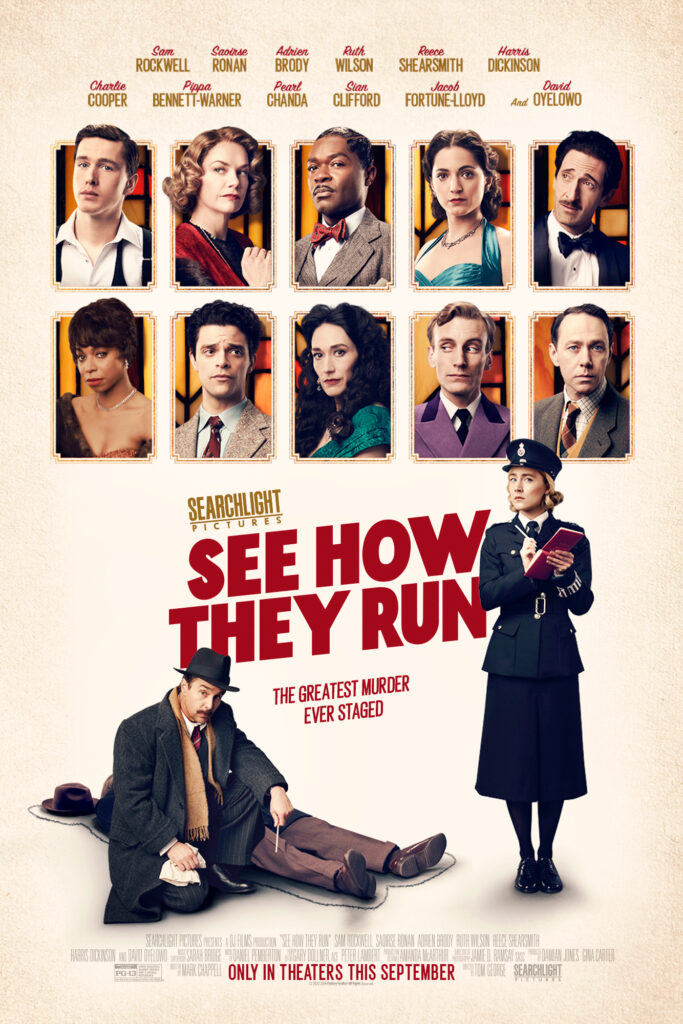Review: “See How They Run”
By Kieran Caves, Contributing Writer

“See How They Run” (Photo Courtesy of Searchlight Pictures)
“See How They Run,” directed by Tom George, is a sly spoof on a whodunit murder-mystery, and while this might sound tiresome to many, it proves itself as quite playful and enjoyable. From the first lines of narration, which come from the caricature of a detestable, narcissistic Hollywood Director, played by Adrien Brody, “See How They Run” makes its intentions clear: to make fun of mysteries while simultaneously showing why they carry so much appeal. Brody’s character, Leo Köpernick, says of whodunits, “if you’ve seen one, you’ve seen them all,” and while the film fully admits this to be true, the amount of fun the director and actors have in proving this statement, is intoxicating.
Set against the backdrop of 1950s London, a prologue of sorts introduces us to Köpernick, a director trying to make a movie out of Agatha Christie’s play “The Mousetrap,” though he despises the play. He despises it because of how derivative it is of everything in the genre, and all the “annoying” tropes he lists off end up appearing in “See How They Run” in hilariously faithful fashion. After declaring that it’s always the least likable character who gets “bumped off,” Köpernick proceeds to be the object of the audience’s hate for a couple of minutes, before he himself is killed. Enter Inspector Stoppard (Sam Rockwell) and Constable Stalker (Saoirse Ronan), who are, respectively, the hardened, sour detective and the new, eager-to-prove-herself recruit. This duo is the best part of the movie; Rockwell is constantly wrapped up in a topcoat, face poking out under a black hat, with a limp he “picked up in the war.” He seems to be having the time of his life playing up all the stereotypes of the detective. Ironically, the last time I had this much fun watching Rockwell was when he defied all the stereotypes of a Nazi officer in “Jojo Rabbit.” Ronan’s performance is equally enjoyable, as her character provides some of the best comedic moments, like writing down every detail of the case in a notebook that should be far too small for anything but the briefest notes. In one of the better meta jokes, Ronan’s Constable Stalker jumps to every conclusion possible, accusing each victim out loud as each piece of “perfect” evidence is given, just as viewers might be thinking “it must be him!” in their heads.
Tom George doesn’t deconstruct the tropes of the genre as much as he plays around with how much fun can be had in making fun of them: there’s interviews with each individual suspect, note-taking, red herrings, and eventually a big house with the perfect drawing room for the denouement. At one point, one of the suspects mentions the inevitable “random detail” which will end up solving the case—part of the fun of “See How They Run” comes in wondering which of the many such details will become —all served on a silver platter— “the one.” There are countless references to Christie’s “The Mousetrap” and other such mysteries—almost everyone’s name is some allusion or joke, and a wink could follow half the lines of dialogue. At one point a character laments he doesn’t understand what’s going on because he doesn’t “have a background in theater.” As a meta joke, it could be one of the funniest moments of the movie, as surely half the audience has had the same thought at least once (or perhaps every five minutes) during the runtime.
Some of the gags fall short, and you’re never emotionally invested in much of what’s happening, but the way the film plays on expectations and tropes is handled with such wit that it’s hard not to appreciate what has been done here. Everything that the characters, and the audience for that matter, expects to come into play, does—it’s great fun watching such a widely known and loved genre be used in such a playful manner. At one point, someone in the audience at my screening shouted at one of the characters to “be quiet” right as they were told the same thing by another character. This little moment sums up “See How They Run” so perfectly; the movie revels in its predictability, pointing out how much joy there is to be found in how audiences understand genre tropes and narrative techniques. If that’s what the filmmakers wanted audiences to come away with, it’s quite expertly handled.
